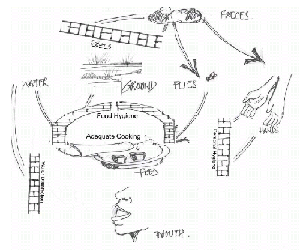<<< Previous
|
|
Next
> >>
|
| WHAT IS SANITATION ? |
Whatever ones definition of sanitation, surely , for it to
be considered "sanitary", it must be ensure that it does not cause disease
or even discomfort for all, and the environment.  This means that the sanitary system must effectively block the spread of pathogens, by creating barriers between the pathogen and food and the body. As shown in this diagram, the barriers are created by personal hygiene, food hygiene, water disinfection, and adequate cooking. While these barriers represent what you can do at the personal level become inadequate, when at the community level we do not have barrier of toilets, safe disposal of waste. Thus Sanitation means more than toilets. It includes collecting and disposing human excreta and urine, as well as other waste water, in a manner that is "sanitary" (safe and healthy). Thus "sanitation" covers all aspects of environment and household cleanliness as well as personal hygiene- human excreta and waste water disposal, garbage and cattle dung disposal, use of smoking chulhas, clean houses and food. UN's world summit on sustainable development, 2002 outlined the following activities and programmes as essentials towards good sanitation.
|
d |
Setting up…
Using…
Promotion of…
The Millennium Development Goal 7 which deals with ensuring environmental sustainability, emphaised the need to halve proportion of people suffering the lack of access to safe drinking water and basic sanitation by 2017. In the same goal, it spoke of integrating sustainable development principles into country programmes to reverse the loss of environmental resources. |
<<< Previous
|
|
Next
> >>
|